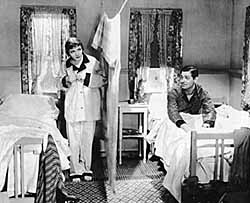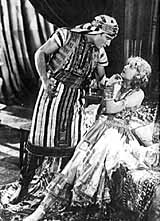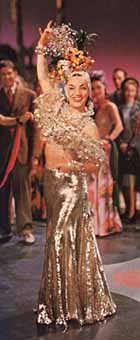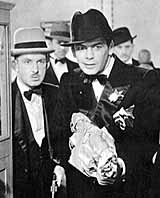1 Indeed, Gable was only "there" to take off his shirt in It Happened One Night because MGM, the studio to which he was under contract, loaned him out to the low-budget Columbia as punishment for some recent recalcitrant behavior.
|

Claudette Colbert and Clark Gable
in It Happened One Night
|
Conclusions about stars and stardom have often been too economically pat and culturally wrong-headed. For instance, when Barry King writes that "the ideology of stardom, with its associated individualism, protects the studio from the risk of their property becoming public domain," he ignores the fact that in a real sense all star images are in the "public domain." MGM may have owned the image of Garbo for many years, but the public possessed it. Moreover, as Richard Dyer notes in Stars (still the most comprehensive summary treatment of the phenomenon), the operation of the star system depended on a careful balance between singularity and plentitude: "From the perceptive of ideology, analyses of stars, as images existing in films and other media texts, stress their structured polysemy, that is, the finite multitude of meanings and affects they embody and the attempt so to structure them that some meanings and affects are foregrounded and others are masked or displaced" (3). Carmen Miranda could never be a "real star" because her "meanings" were too limited. Conversely, Paul Muni (e.g., as Scarface, Zola and the victimized hero in I Am a Fugitive from a Chain Gang) carried too many conflicting "meanings" to maintain stardom, at least in the essentially romantic sense that obtained in the 1930s.
What so many responses to the phenomenon of stardom share is basically an ahistorical approach, one that collapses fifty years (or more) of film history, one that often privileges archetypal performances (e.g., the Bogart of Casablanca, but not the Bogart of Battle Circus), one that insists that "stars are more subjects than instruments of the their films" (Thompson, 242), and one that engages in a kind of cultural speculation ("What then have 'the stars' to tell us about our experience?" [Durgnat, 166]), that must remain highly subjective and debatable. Yet, as David Bordwell cogently insists, the star can and should be seen as an integral and explicable element in the carefully codified Hollywood "mode of production":
The classical Hollywood film presents psychologically defined individuals who struggle to solve a clear-cut problem or to attain specific goals. In the course of this struggle, the characters enter into conflict with others or with external circumstances. The story ends with a decisive victory or defeat, a resolution of the problem and a clear achievement or non-achievement of the goals. The principal causal agency is thus the character, a discriminated individual endowed with a consistent batch of evident traits, qualities and behaviors. Although the cinema inherits many conventions of portrayal from theater and literature, the character types of melodrama and popular fiction get fleshed out by the addition of unique motifs, habits, or behavioral tics. In parallel fashion, the star system has as one of its functions the creation of a rough character prototype for each star which is then adjusted to the particular needs of the role. The most 'specified' character is usually the protagonist, who becomes the principal causal agent, the target of any narrative restriction, and the chief object of any audience identification. (157)
The classical-era star system, to follow out the implications of Bordwell's overview, can be seen then to operate via the inevitable interplay of the star as person, actor, prototype and character in any given film. For example, Jimmy Stewart in It's a Wonderful Life (1946) is the returned war hero, a grown-up version of the squeaky-voiced innocent of his 1930s films, and an actor/character facing the perils, both personal and professional, of encroaching middle age. (As discussed in Part Seven, Stewart brilliantly triumphed over these perils, at least professionally.)
"Stardom" has always been fraught with the paradoxes of American interpretations of individualism--and not just in the simple sense that for decades the studios very much controlled what "individual" stars could be, or even in the sense that the star's "monopoly on a personality" inevitably meant commodification and a restrictive standardization that inhibited genuine individualism. Rather, the whole complex construction of "stars" was paradoxical from its inception and continued to evolve in highly problematic and paradoxical ways. This paradoxical quality is much more evident when we consider the full historical context of the star system rather than just the evidence of the films themselves, for Hollywood was very good, indeed brilliant, at creating a mythic screen image of each star as a rare, intense (and usually beautiful) individual. The following study surveys briefly and in roughly chronological order, seven indicative and inherently paradoxical events in the evolution of the American "star system," suggesting how the seeming individuality of stardom often masked the communal efforts supporting it, the authoritarian control defining it, and the hidden brokers devising it. Ruby Stevens of Brooklyn, New York, only became Barbara Stanwyck of Hollywood, California, by entering a very complex systematic evolution at a precise historical moment.
page 1 of 9


 If, as Janet Staiger observes in The Classical Hollywood Cinema, "economically, the star may be thought of as a monopoly on a personality" (101), then it is a curious sort of monopoly--a monopoly held jointly, and in varying degrees, by all those concerned with the production and consumption of American films: most specifically, the filmmaking industry, the star himself or herself, and the audience. Bogart as the half-cynical romantic hero, Stanwyck as the wise-cracking "dame," Wayne as the stoic, deadly Westerner--all these were, to echo Coleridge, the result of a "willing suspension of disbelief" on the part of producers and consumers, even on the part of the stars themselves.
If, as Janet Staiger observes in The Classical Hollywood Cinema, "economically, the star may be thought of as a monopoly on a personality" (101), then it is a curious sort of monopoly--a monopoly held jointly, and in varying degrees, by all those concerned with the production and consumption of American films: most specifically, the filmmaking industry, the star himself or herself, and the audience. Bogart as the half-cynical romantic hero, Stanwyck as the wise-cracking "dame," Wayne as the stoic, deadly Westerner--all these were, to echo Coleridge, the result of a "willing suspension of disbelief" on the part of producers and consumers, even on the part of the stars themselves.

 Although it is hard to gainsay Andrew Tudor's judgment that "the star system, then, is the central factor in the psychology of the movie audience" (82), there has probably been, until recently, less of historical and critical value written about the star system than about almost any other major aspect of American cinema. By contrast, Hollywood itself has produced a voluminous stream of official and unofficial publicity about specific stars, about the usual glories, and occasional miseries, of stardom. (See
Although it is hard to gainsay Andrew Tudor's judgment that "the star system, then, is the central factor in the psychology of the movie audience" (82), there has probably been, until recently, less of historical and critical value written about the star system than about almost any other major aspect of American cinema. By contrast, Hollywood itself has produced a voluminous stream of official and unofficial publicity about specific stars, about the usual glories, and occasional miseries, of stardom. (See 


